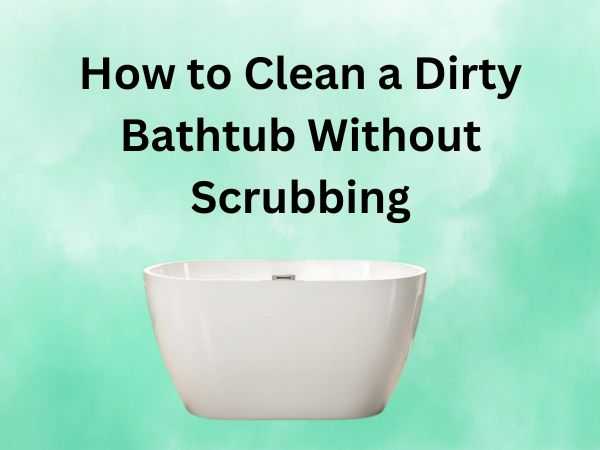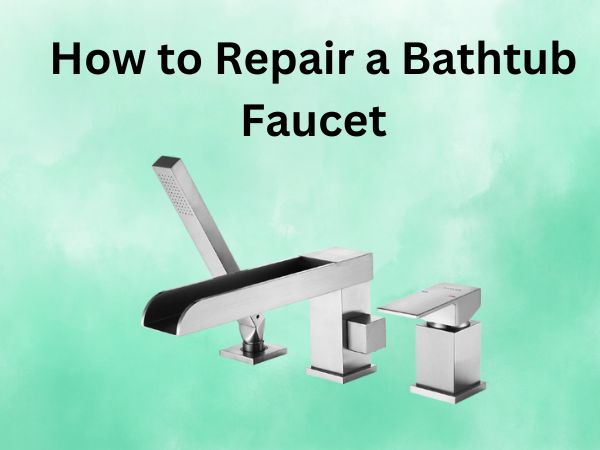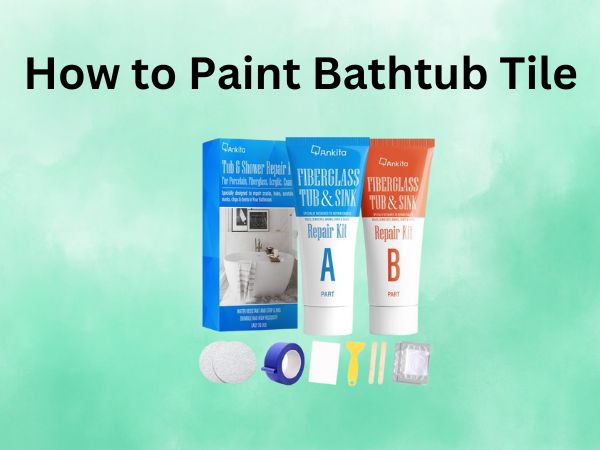How to Clean a Dirty Bathtub Without Scrubbing [Effortless Methods That Work]
Let’s be honest – scrubbing a bathtub is nobody’s idea of a fun Saturday activity. It’s hard on your knees, tough on your back, and somehow manages to leave you more exhausted than an intense workout. But what if I told you that gleaming, sparkling bathtub of your dreams is possible without the backbreaking labor? That’s right – you can ditch the scrub brush and still achieve amazing results. In this guide, I’ll show you exactly how to clean a dirty bathtub without scrubbing, using smart techniques and effective products that do the hard work for you.
Table of Contents
Why Traditional Scrubbing Is a Pain
Before we dive into the solutions, let’s talk about why we want to avoid scrubbing in the first place.
Physical Strain and Time Consumption
Traditional bathtub scrubbing is essentially a workout disguised as a chore. You’re bending awkwardly, putting pressure on your knees, straining your back, and vigorously working your arm muscles – often for 30 minutes or more. For people with arthritis, back problems, or other physical limitations, this can be more than inconvenient – it can be impossible.
Even for those without physical limitations, scrubbing represents a significant time investment in our already busy lives. Who wants to spend precious weekend hours hunched over a bathtub when there are so many more enjoyable things to do?
Potential Damage to Bathtub Surfaces
Beyond the physical toll, aggressive scrubbing can actually damage your bathtub over time. Abrasive cleaning tools like stiff brushes and harsh scouring pads can scratch and wear down your tub’s finish. This is especially true for acrylic and fiberglass tubs, which are particularly vulnerable to scratching. Once the surface is compromised, it actually becomes harder to clean and more prone to staining and damage – creating a vicious cycle that leads to more scrubbing.
Essential Supplies for No-Scrub Bathtub Cleaning
Before we get into specific methods, let’s gather our arsenal of cleaning supplies. Having the right tools makes all the difference in achieving scrub-free success.
Natural Cleaning Ingredients
Many effective no-scrub cleaners can be made from ingredients you likely already have at home:
- White vinegar: The acid in vinegar dissolves soap scum and mineral deposits
- Baking soda: A gentle abrasive that helps lift stains
- Dawn dish soap (or similar): Cuts through grease and body oils
- Hydrogen peroxide: Natural bleaching agent for stain removal
- Cream of tartar: Works wonders on tough bathtub rings
- Lemon juice: Natural acid that brightens and helps remove soap scum
These natural options are not only effective but also more environmentally friendly and often gentler on your skin than harsh chemicals.
Commercial No-Scrub Products
If you prefer ready-made solutions, several commercial products are designed specifically for no-scrub cleaning:
- Foaming bathroom cleaners that cling to vertical surfaces
- Spray-and-leave shower cleaners
- Oxygen bleach cleaners
- Specialized bathtub cleaning bombs (similar to bath bombs, but for cleaning)
- Gel-based thick cleaners designed to adhere to tub surfaces
While these products tend to contain stronger chemicals, they often require even less effort than DIY solutions.
Tools and Accessories
Even in scrub-free cleaning, having the right tools makes application easier:
- Spray bottles for DIY mixtures
- Microfiber cloths for gentle wiping
- A squeegee for removing excess water
- An extendable-handle sponge (for minimal-effort wiping)
- Rubber gloves to protect your hands
- A shower head or handheld sprayer for rinsing
Powerful DIY No-Scrub Cleaning Solutions
Now let’s look at some specific cleaning mixtures you can make at home that will do the dirty work for you.
Vinegar and Dawn Method
This is perhaps the most famous no-scrub bathtub cleaner, and for good reason – it works incredibly well on soap scum and general bathtub grime.
Here’s the magic formula:
- Heat 2 cups of white vinegar in the microwave until hot (but not boiling)
- Pour the hot vinegar into a spray bottle
- Add 2 tablespoons of Dawn dish soap (the blue original kind works best)
- Gently shake to mix
The heat activates the vinegar’s cleaning power, while the Dawn cuts through body oils and soap residue. Simply spray this mixture liberally all over your dirty tub, and leave it to work for 30 minutes to an hour. The longer it sits, the less effort you’ll need later. When time’s up, simply rinse thoroughly with warm water. For any stubborn spots, a light wipe with a microfiber cloth should do the trick – no scrubbing needed!
Baking Soda and Hydrogen Peroxide Magic
This combination is particularly effective on stained bathtubs and works wonders on soap scum buildup.
To make this cleaner:
- Sprinkle a generous amount of baking soda all over the damp bathtub surface
- Spray hydrogen peroxide (the standard 3% solution from drugstores) over the baking soda
- Add a few drops of dish soap on top
- Let the mixture sit for 1-2 hours
The chemical reaction between these ingredients helps lift stains and dissolve grime. After waiting, you’ll find most dirt rinses away easily. For any remaining residue, a gentle wipe with a soft cloth should suffice – the abrasive work has already been done by the chemical reaction.
Extra Tough Stains: Cream of Tartar Paste
For those stubborn bathtub rings or mineral deposits that resist other methods, cream of tartar is your secret weapon:
- Make a paste using 1/4 cup cream of tartar and enough hydrogen peroxide to create a thick consistency
- Apply directly to stains and discolored areas
- Let sit for at least 30 minutes (overnight works even better)
- Rinse away with warm water
This paste is particularly effective on rust stains and hard water deposits that other cleaners struggle with. The mild acid in cream of tartar dissolves mineral buildup without damaging most tub surfaces.
Step-by-Step No-Scrub Cleaning Methods
Now that we have our cleaning solutions ready, let’s look at specific techniques that maximize their effectiveness.
The Hot Water Soak Technique
This method is especially effective for tubs with plugs that hold water:
- Put a towel in the bottom of the tub for comfort and to protect the surface
- Fill your tub with the hottest water your tap can produce (about 3-4 inches deep)
- Add 2 cups of vinegar and 1/4 cup dish soap to the water
- Let the solution soak for 30 minutes to an hour
- Drain the tub and rinse thoroughly
The hot water helps activate the cleaning ingredients and softens built-up grime. The heat expands the pores in porcelain and other materials, allowing the cleaning solution to penetrate deeper. As the tub drains, most of the loosened dirt goes with it.
The Spray and Wait Method
For those who don’t want to fill the tub or for vertical surfaces like shower walls:
- Thoroughly wet all surfaces with warm water
- Apply your chosen cleaning solution generously (either DIY or commercial)
- Allow to sit for the recommended time (typically 30 minutes to 2 hours)
- Rinse thoroughly using a showerhead or buckets of clean water
The key to this method is patience and generous application of your cleaner. Make sure every dirty surface is thoroughly coated, and don’t rush the waiting period – this is when the chemical action is breaking down the dirt for you.
Overnight Cleaning Hacks
For extremely dirty tubs or those with years of buildup, overnight treatments provide the most dramatic results:
- Apply your chosen cleaner generously in the evening
- For vertical surfaces, look for gel-based cleaners that will adhere without running off
- Cover with plastic wrap if using paste-like cleaners to prevent drying out
- Let sit overnight (8-12 hours)
- Rinse thoroughly in the morning
While you sleep, the cleaners have hours to break down even the most stubborn grime. This extended contact time often eliminates the need for any scrubbing whatsoever – even on tubs that haven’t been cleaned in months.
Specialized Solutions for Different Bathtub Materials
Different bathtub materials require slightly different approaches for optimal results.
Porcelain and Ceramic Tubs
Porcelain and ceramic tubs are quite durable and can handle most cleaning solutions, including acidic ones like vinegar.
Best approach:
- The vinegar and Dawn method works exceptionally well
- For stains, baking soda and hydrogen peroxide paste is highly effective
- These surfaces can tolerate overnight treatments without damage
- Avoid abrasive powders that can scratch the finish
Acrylic and Fiberglass Tubs
These materials require a gentler touch as they scratch more easily:
Best approach:
- Avoid pure vinegar – always dilute it at least 50/50 with water
- Dawn dish soap alone can be surprisingly effective
- Baking soda should be used sparingly and gently rinsed, never “scrubbed in”
- Rinse thoroughly to prevent any cleaner residue from damaging the surface
- Commercial cleaners specifically formulated for acrylic are worth the investment
Special Care for Antique Clawfoot Tubs
These classic beauties often have unique finishes that need extra care:
Best approach:
- Test any cleaner on an inconspicuous spot first
- Avoid acidic cleaners if your tub has a specialty finish or real metal fixtures
- For enamel clawfoot tubs, a baking soda paste left to sit works gently
- After cleaning, consider applying a specialized enamel or porcelain wax for protection
Preventing Future Buildup: Maintenance Tips
The easiest tub to clean is one that never gets too dirty in the first place. These maintenance habits can dramatically reduce your cleaning frequency.
Daily and Weekly Prevention Habits
Simple routines that take seconds can save you hours of cleaning later:
- Keep a squeegee in the shower and quickly run it over walls after each use
- Spray the tub with a daily shower spray after your final bath or shower of the day
- Keep a microfiber cloth nearby to quickly wipe away shampoo or soap spills
- For bathtubs, rinse thoroughly after using bath oils or bath bombs
- Consider installing a water softener shower head attachment to reduce mineral buildup
Water Quality Solutions
Hard water is often the culprit behind the most stubborn bathtub stains. Address the source with these solutions:
- Install a whole-house water softener if hard water is a major issue
- Use filters on showerheads to reduce mineral content
- For rental homes, consider portable water softening solutions
- Periodically deep clean showerheads and faucets to prevent mineral buildup that can splash onto tub surfaces
By implementing these preventative measures, you might find you only need to deep clean your tub every few months rather than weekly.
Frequently Asked Questions
Q: How often should I deep clean my bathtub if I’m using these no-scrub methods?
A: With regular maintenance (quick rinses and daily spray), most bathtubs only need a deep no-scrub cleaning every 2-4 weeks. However, this depends on frequency of use, water hardness, and whether you’re implementing the prevention strategies. Homes with hard water or tubs used by multiple people daily may need more frequent attention.
Q: Are these no-scrub methods safe for all plumbing systems?
A: Most of these methods are safe for standard plumbing systems. However, if you have a septic system, use vinegar-based cleaners sparingly as large amounts could potentially disrupt the bacterial balance in your tank. Additionally, avoid pouring baking soda and vinegar mixtures directly down drains as the foaming action occurs too quickly to be effective in clearing clogs.
Q: Can I use these methods if my bathtub has caulking that’s starting to mold?
A: While these methods will clean the bathtub surface, severely moldy caulking usually requires specialized treatment or replacement. For mild mildew on caulk, hydrogen peroxide left to sit for several hours can help. For persistent mold issues, you may need to remove and replace the caulking entirely for a truly clean result.
Q: What’s the safest no-scrub method for households with pets and small children?
A: The vinegar and dish soap method is generally considered safest for households with pets and children, as it avoids harsh chemicals. Just be sure to rinse thoroughly after cleaning. For even greater safety, use simple baking soda paste (baking soda and water) followed by a vinegar spray after the paste has dried. This creates a safe foaming action that lifts dirt without dangerous chemicals.
Q: My bathtub has rust stains that won’t come out with regular cleaners. What no-scrub method works best?
A: For stubborn rust stains, lemon juice and salt paste left overnight works wonders without scrubbing. Commercial products containing oxalic acid are also effective on rust stains – just spray and leave them to work for the recommended time. For truly stubborn rust stains in porcelain tubs, a paste of cream of tartar and hydrogen peroxide left overnight often succeeds where other methods fail.
Enjoy Your Clean Bathtub Without the Elbow Grease
Cleaning your bathtub doesn’t have to be a dreaded, physically demanding chore. With these no-scrub methods, you can achieve a sparkling clean tub with minimal effort. The key is using the right products, giving them sufficient time to work their magic, and being consistent with simple maintenance routines.
Remember that different tubs may respond better to certain methods, so don’t be afraid to experiment until you find the perfect solution for your bathroom. Whether you opt for commercial products or DIY mixtures, the freedom from scrubbing will transform your cleaning routine.
Next time you’re faced with a dirty bathtub, put down that scrub brush, pick up a spray bottle, and let chemistry do the hard work for you. Your back, knees, and schedule will thank you – and you’ll still get to enjoy that wonderfully clean bathtub feeling.



